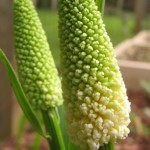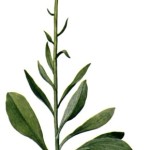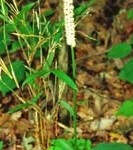False Unicorn Root – Chamaelirium luteum
|
Current Demand = Normal |
Parts Used: Rhizome & Root |
 |
 |
 |
Family: Melanthiaceae
Common Names: helionas root, blazing star root, devil’s bit, starwort…
Description:
False Unicorn is a herbaceous perennial, native to North American east of the Mississippi. It flowers in May and June. The stems are 1-3 feet high, smooth, angular with leaves that alternate which are spatulate below and lanceolate above. There are numerous small greenish-white flowers in a dense terminal raceme that nods like a plume. The bulbous rhizome terminates abruptly and gives off fine wiry pale roots.
Planting/Cultivation
Likes low moist ground, such as bogs, wet woodlands, meadows and thickets.
Harvesting/Drying
Parts Used: rhizome and root
Collection: In September, after flowering. Remove root from stem at ground level.
After harvest, the roots should be washed in cold water and foreign material (rocks, dirt, other roots) must be removed. Unless your buyer is purchasing fresh dug roots (which they often do) the clean roots need to be dried. Large roots will need to be split in half to allow drying. False Unicorn Root can be dried in the sun although if possible dry indoors in a well ventilated barn loft or attic to protect from the elements. If natural heat is not available, you may need to add heat to a room and a fan for continuous airflow. The key to drying any root herb or bark is an even combination of heat and airflow. Never dry in an oven or microwave.
The roots will be completely dry (largest root will snap not bend), in approximately 5-10 days, depending on the size of the root and drying conditions. Place the dried roots carefully into a cardboard box or paper bag for storage in a dry area until you are ready to sell or use. Do not store in plastic or it will mold.
Attributes (Images)
Southwest School Botanical Medicine
Charles T. Bryson, USDA Agricultural Research Service, Bugwood.org
 Root Buyer
Root Buyer